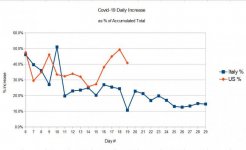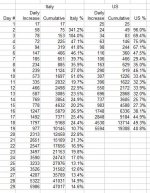IdahoMtnSpyder
Active member
There's a lot of stuff floating around the Internet about Covid-19 so I thought I'd share some info that I believe is as reliable as can be. This is in the interest of presenting facts, not fear. The graphs below come from https://www.worldometers.info/coronavirus/. Another reliable website with numbers regularly updated is https://coronavirus.jhu.edu/map.html.
First, if you buy lottery tickets because "maybe, just maybe" you will hit the jackpot take note that your chances of winning the Powerball are on the order of 1 in 300 million. Today, your chances of contracting Covid-19 are about 1 in 20 thousand. That chance increases each day as the reported cases numbers increase.
Here are two graphs of the day to day number of cases of Covid-19 in the US. The first one is a linear graph which shows the total number on the Y axis. The second one is a logarithmic graph that shows how the numbers go up in a multiplying fashion, i.e., the number of days to go from 1 to 10, 10 to 100, 100 to 1000, and so on. What I don't know is how much these numbers are impacted by the increasing number of tests performed each day, but the general trends are valid.
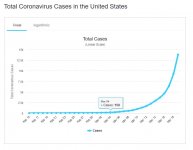
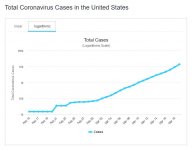
Note that the log graph shows the line bending slightly more upward the past few days. That means the time to go the next multiple of 10 is getting shorter.
For comparison here are the graphs for Italy, the hottest of the hot spots in Europe.
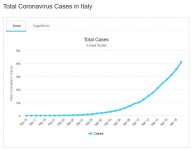
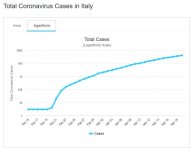
What I find interesting is the Italy linear graph doesn't climb as rapidly as the US graph. For the time frame ending yesterday, 3/19, in Italy the time for the number to multiply by 100 was about 21 days. Here in the US it was about 16 days. This is in spite of the fact the US population density, overall, is only 1/6 of that of Italy.
Here are the graphs for China, where it all started.

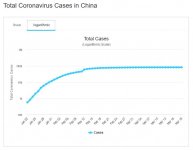
I see two take aways from these graphs. Clamping down severely on the movement of people stems the growth of the virus. If you recall from the news China prohibited unnecessary travel as soon as they recognized there was a real problem. That will not happen in the this country to the same degree. The other take away is the growth in infections will decrease in time.
There are many more numbers and graphs on the website above.
This information should dispel any notion that Covid-19 is not the problem the news media makes it out to be. It is. And it should drive home the necessity of restricting travel and personal contacts, the primary transmission method. Yes, there are many unknowns such as how contagious is someone between being infected and starting to show symptoms. In a report this morning on NPR a woman said she infected 4 out 6 lunch companions at a lunch a day before she started having symptoms.
If in the next 10 days the number of infections goes up by a factor of 10 as the graphs indicate it well could, then the number of infections will be on the order of 1 in 2000. For me anyway, that probability is too high for comfort.
ARTraveler, and others who know statistics, please correct any misinformation I may included above. This issue is too serious to leave bad information floating out there.
First, if you buy lottery tickets because "maybe, just maybe" you will hit the jackpot take note that your chances of winning the Powerball are on the order of 1 in 300 million. Today, your chances of contracting Covid-19 are about 1 in 20 thousand. That chance increases each day as the reported cases numbers increase.
Here are two graphs of the day to day number of cases of Covid-19 in the US. The first one is a linear graph which shows the total number on the Y axis. The second one is a logarithmic graph that shows how the numbers go up in a multiplying fashion, i.e., the number of days to go from 1 to 10, 10 to 100, 100 to 1000, and so on. What I don't know is how much these numbers are impacted by the increasing number of tests performed each day, but the general trends are valid.


Note that the log graph shows the line bending slightly more upward the past few days. That means the time to go the next multiple of 10 is getting shorter.
For comparison here are the graphs for Italy, the hottest of the hot spots in Europe.


What I find interesting is the Italy linear graph doesn't climb as rapidly as the US graph. For the time frame ending yesterday, 3/19, in Italy the time for the number to multiply by 100 was about 21 days. Here in the US it was about 16 days. This is in spite of the fact the US population density, overall, is only 1/6 of that of Italy.
Here are the graphs for China, where it all started.


I see two take aways from these graphs. Clamping down severely on the movement of people stems the growth of the virus. If you recall from the news China prohibited unnecessary travel as soon as they recognized there was a real problem. That will not happen in the this country to the same degree. The other take away is the growth in infections will decrease in time.
There are many more numbers and graphs on the website above.
This information should dispel any notion that Covid-19 is not the problem the news media makes it out to be. It is. And it should drive home the necessity of restricting travel and personal contacts, the primary transmission method. Yes, there are many unknowns such as how contagious is someone between being infected and starting to show symptoms. In a report this morning on NPR a woman said she infected 4 out 6 lunch companions at a lunch a day before she started having symptoms.
If in the next 10 days the number of infections goes up by a factor of 10 as the graphs indicate it well could, then the number of infections will be on the order of 1 in 2000. For me anyway, that probability is too high for comfort.
ARTraveler, and others who know statistics, please correct any misinformation I may included above. This issue is too serious to leave bad information floating out there.

